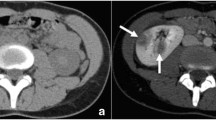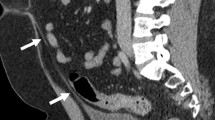Abstract
Background
The incidence of pediatric nephrolithiasis in the United States is increasing. There is a paucity of literature comparing the diagnostic performance of computed ultrasound (US) to tomography (CT) in the pediatric population.
Objective
To determine the diagnostic performance of renal US for nephrolithiasis in children using a clinical effectiveness approach.
Materials and methods
Institutional review board approval with a waiver of informed consent was obtained for this retrospective, HIPAA-complaint investigation. Billing records and imaging reports were used to identify children (≤18 years old) evaluated for nephrolithiasis by both US and unenhanced CT within 24 h between March 2012 and March 2017. Imaging reports were reviewed for presence, number, size and location of kidney stones. Diagnostic performance of US (reference standard=CT) was calculated per renal unit (left/right kidney) and per renal sector (four sectors per kidney). For sector analysis, US was considered truly positive if a stone was identified at CT in the same or an adjacent sector.
Results
There were 68 renal stones identified by CT in 30/69 patients (43%). Mean patient age was 14.7±3.6 years, and 35 were boys. For detecting nephrolithiasis in any kidney, US was 66.7% (48.8–80.8%) sensitive and 97.4% (86.8–99.9%) specific (positive predictive value=95.2% [77.3–99.8%], negative predictive value=79.2% [65.7–88.3%], positive likelihood ratio=26.0). Per renal sector, US was 59.7% (46.7–71.4%) sensitive and 97.4% (95.5–98.5%) specific (positive predictive value=72.3% [58.2–83.1%], negative predictive value=95.4% [93.2–96.9%], positive likelihood ratio=22.5). Of the 30 stones not detected by US, only 3 were >3 mm at CT.
Conclusion
In clinical practice, US has high specificity for detecting nephrolithiasis in children but only moderate sensitivity and false negatives are common.




Similar content being viewed by others
References
Dwyer ME, Krambeck AE, Bergstralh EJ et al (2012) Temporal trends in incidence of kidney stones among children: a 25-year population based study. J Urol 188:247–252
Routh JC, Graham DA, Nelson CP (2010) Epidemiological trends in pediatric urolithiasis at United States freestanding pediatric hospitals. J Urol 184:1100–1104
Tasian GE, Ross ME, Song L et al (2016) Annual incidence of nephrolithiasis among children and Aadults in South Carolina from 1997 to 2012. Clin J Am Soc Nephrol 11:488–496
Expert Panel on Pediatric Imaging (2012) ACR appropriateness criteria hematuria - child. American College of Radiology. https://acsearch.acr.org/docs/69440/Narrative/. Accessed 15 Nov 2017
Fulgham PF, Assimos DG, Pearle MS et al (2013) Clinical effectiveness protocols for imaging in the management of ureteral calculous disease: AUA technology assessment. J Urol 189:1203–1213
Riccabona M, Avni FE, Blickman JG et al (2009) Imaging recommendations in paediatric uroradiology. Minutes of the ESPR uroradiology task force session on childhood obstructive uropathy, high-grade fetal hydronephrosis, childhood haematuria, and urolithiasis in childhood. ESPR annual congress, Edinburgh, UK, June 2008. Pediatr Radiol 39:891–898
Tasian GE, Pulido JE, Keren R et al (2014) Use of and regional variation in initial CT imaging for kidney stones. Pediatrics 134:909–915
Gartlehner G, Hansen RA, Nissman D et al (2006) Criteria for distinguishing effectiveness from efficacy trials in systematic reviews. Agency for Healthcare Research and Quality (US), Rockville (MD)
Centers for Disease Control and Prevention BMI percentile calculator for child and teen. https://nccd.cdc.gov/dnpabmi/calculator.aspx. Accessed 15 Nov 2017
Masch WR, Cohan RH, Ellis JH et al (2016) Clinical effectiveness of prospectively reported sonographic twinkling artifact for the diagnosis of renal calculus in patients without known urolithiasis. AJR Am J Roentgenol 206:326–331
Routh JC, Graham DA, Nelson CP (2010) Trends in imaging and surgical management of pediatric urolithiasis at American pediatric hospitals. J Urol 184:1816–1822
Passerotti C, Chow JS, Silva A et al (2009) Ultrasound versus computerized tomography for evaluating urolithiasis. J Urol 182:1829–1834
Winkel RR, Kalhauge A, Fredfeldt KE (2012) The usefulness of ultrasound colour-Doppler twinkling artefact for detecting urolithiasis compared with low dose nonenhanced computerized tomography. Ultrasound Med Biol 38:1180–1187
Palmer JS, Donaher ER, O'Riordan MA et al (2005) Diagnosis of pediatric urolithiasis: role of ultrasound and computerized tomography. J Urol 174:1413–1416
Jendeberg J, Geijer H, Alshamari M et al (2017) Size matters: the width and location of a ureteral stone accurately predict the chance of spontaneous passage. Eur Radiol 27:4775–4785
Uppot RN, Sahani DV, Hahn PF et al (2006) Effect of obesity on image quality: fifteen-year longitudinal study for evaluation of dictated radiology reports. Radiology 240:435–439
Aytac SK, Ozcan H (1999) Effect of color Doppler system on the twinkling sign associated with urinary tract calculi. J Clin Ultrasound 27:433–439
Turrin A, Minola P, Costa F et al (2007) Diagnostic value of colour Doppler twinkling artefact in sites negative for stones on B mode renal sonography. Urol Res 35:313–317
Dillman JR, Kappil M, Weadock WJ et al (2011) Sonographic twinkling artifact for renal calculus detection: correlation with CT. Radiology 259:911–916
Author information
Authors and Affiliations
Corresponding author
Ethics declarations
Conflicts of interest
Drs. J. R. Dillman and A. T. Trout receive grant support from Siemens Healthcare and Toshiba America Medical Systems for US research unrelated to this work. Mr. N. P. Roberson, Dr. S. M. O’Hara, Dr. W. DeFoor Jr., Dr. P. P. Reddy, and Mr. R. M. Giordano declare no conflicts of interest.
Rights and permissions
About this article
Cite this article
Roberson, N.P., Dillman, J.R., O’Hara, S.M. et al. Comparison of ultrasound versus computed tomography for the detection of kidney stones in the pediatric population: a clinical effectiveness study. Pediatr Radiol 48, 962–972 (2018). https://doi.org/10.1007/s00247-018-4099-7
Received:
Revised:
Accepted:
Published:
Issue Date:
DOI: https://doi.org/10.1007/s00247-018-4099-7




